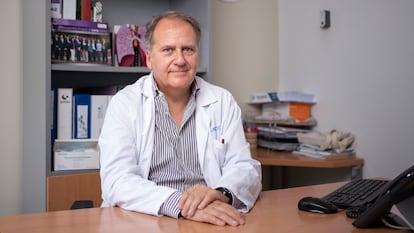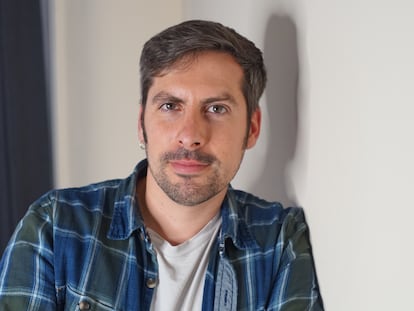Javier de Castro, oncologist: ‘Cancer is different in men and women’
The head of Medical Oncology at La Paz University Hospital in Madrid tells EL PAÍS that many clinical trials set up to test new drugs don’t take gender differences into account

Javier de Castro, 57, is head of Medical Oncology at La Paz University Hospital in Madrid, his hometown. A specialist in lung cancer — “the one with the highest mortality rate,” he points out — he always knew that what he wanted to do in life was become a doctor and treat cancer. “I didn’t have any relatives who were [doctors]... but I knew that was what I wanted to be.”
At the age of 10, de Castro not only knew that he wanted to dedicate his life to medicine, but he also knew what he wanted to specialize in: “Cancer fascinated me. You may say, ‘what does a 10-year-old know about cancer?’ Maybe I was influenced by the fact that a friend of mine had acute leukemia at the time. He was cured. My path was so clear to me that, during my time at school, I focused on science. And, when I had to do any kind of project, I did it on cancer.”
Javier de Castro says that the stigma that cancer still carries also clings to the people who treat it. “As it’s such a serious disease, it seems that oncologists have to suffer a lot, that our work must have a lot of emotional impact. When I meet someone, in any environment, it’s very common for them to tell me (in so many words): ‘Oh, how sad, the further away from you I am, the better.’”
Question. Does that make you sad?
Answer. No, on the contrary. I believe that, in medicine, you must be serious in your work, but you must also have a very large component of empathy. Now, after many years in the profession, I understand this disease from a 360-degree perspective. It’s useless for me to give you a treatment and tell you that it’s going well if your life has changed (for the worse), if you can’t improve, if you have side effects that don’t allow you to have an adequate quality of life. This disease is a tsunami. Our job is to be very technical and very professional to make the best diagnosis and choose the best treatment. Once that’s done, you have to worry about the person. That’s the part of this profession that has advanced the most in recent years. This isn’t about treating diseases… it’s about treating people who have a disease.
Q. A few days ago, in a lecture, you said that cancer is different in women and in men.
A. Certainly, cancer is different in men and women. This is one of the things that we’ve learned. I came to my field in the 1990s — [at the time], specialists said that we dedicated ourselves to lung cancer because nobody else wanted to do it. Lung tumors were number one in terms of mortality. Our patients died after just a year, because, beyond chemotherapy, there wasn’t much that could be done for them. But in recent years, things have changed a lot. All the research that’s been done since the 1980s began to bear fruit in the 2000s. Thanks to that research, we’re beginning to see that there’s a clear gender difference, even within the same tumor. And I’m not merely referring to the fact that there are breast cancers that are overwhelmingly female or prostate cancers that are male.
Q. So those aren’t the only gendered cancers?
A. No. In recent years, we’ve learned to give tumors surnames. It’s no longer a breast adenocarcinoma, but a breast adenocarcinoma with the presence or absence of hormone receptors, with the presence or absence of alterations in an oncogene such as HER2, and so on. What we see now is that you can have a breast tumor that may look more like a lung tumor than other breast tumors — it may possibly have to be treated differently than from how a conventional breast tumor is treated. We know this because we can see the molecular alterations of tumors. And it’s within this context that we see that, for example, almost 80% of lung tumors are associated with tobacco, but only in men. In women, this association falls to 60%. This means that, in 40% of lung tumors affecting women, we don’t know what’s the cause. Because this difference isn’t simply explained by the fact that women typically start smoking later on in life. Another difference is that lung cancer in females who are non-smokers appears in much younger women. We also know that, when the patient is a man and the woman is the caregiver, the care is much better than when the situation is the other way around.
We also know that, when the patient is a man and the woman is the caregiver, the care is much better than when the situation is the other way around.
Q. What are the implications of this?
A. In the case of lung cancer in non-smokers, it so happens that it’s typically diagnosed later, because when a woman who is 30 or younger has respiratory problems, doctors often don’t consider lung cancer to be the first possible cause.
Q. Are there other differences between men and women regarding cancer?
A. Regarding the drugs we use [for treatment], there are also important differences. I’m going to give you an example that’s very crude, but it allows you to understand the situation perfectly. If a woman consumes alcohol, she becomes intoxicated much faster — due to her weight and metabolism — than a man who weighs 220 pounds and has a much slower metabolism. What we clearly see when it comes to having two drinks or having five is the same with pharmaceuticals.

Q. Is there enough information about how these drugs affect women and men differently?
A. No. What we see is that the clinical trials — where new drugs are developed — have often not been carried out while taking into consideration the differing weights and metabolic rates of men and women.
Q. Does this mean that the sex of the participants hasn’t been considered when designing the trials?
A. It’s simply contemplated when it comes to reporting that ‘so many women have been included.’ Because in the past, clinical trials were done much more with men than with women. But, for example, the limiting dose of drug toxicity isn’t designed based on whether a woman or a man is being medicated.
The limiting dose of drug toxicity isn’t designed based on whether a woman or a man is being medicated.
Q. That is, the woman’s body is treated as if it were a man’s...
A. Yes, women are incorporated as if we’re all the same. The differential fact isn’t being established. It’s true that there are very obvious differential factors, such as avoiding pregnant women [in the tests]. But there are other factors that aren’t considered.
Q. And those differential factors that influence cancer treatment, are they merely biological, or are there also differences marked by gender?
A. No, they aren’t solely biological. There are differences in life habits and there are differences in social impact. The incorporation of women into the workplace may be different from that of men, [just as] the role of women in the family sphere — especially in what has to do with care — continues to be much more predominant than that of men. So we know that, for instance, when the patient is a man and the woman is the caregiver, the care is much better than when the situation is reversed.
Q. Does everything you’ve explained occur in all cancers?
A. This is the model that I see in lung cancer, but we know that colon cancer also behaves differently in men and women. We have to design studies taking into account this differential fact, until we obtain information regarding how the evolution or the impact will be at all levels when the cancer is in a woman. It’s evident that the gendered perspective must be incorporated.
Q. You’re speaking in the future tense, meaning that this hasn’t been done yet, correct?
A. Well, this information is all very new. The HER2 alteration became known at the end of the last century or beginning of this century. The first treatable lung alteration was discovered in 2004. We’ve now been using targeted treatments for just nine years. It’s been a dynamic process, during which we’ve been asking ourselves — when lung cancer suddenly appears in a 30-year-old woman — why does this happen to women, if it doesn’t happen to men?
Sign up for our weekly newsletter to get more English-language news coverage from EL PAÍS USA Edition
Tu suscripción se está usando en otro dispositivo
¿Quieres añadir otro usuario a tu suscripción?
Si continúas leyendo en este dispositivo, no se podrá leer en el otro.
FlechaTu suscripción se está usando en otro dispositivo y solo puedes acceder a EL PAÍS desde un dispositivo a la vez.
Si quieres compartir tu cuenta, cambia tu suscripción a la modalidad Premium, así podrás añadir otro usuario. Cada uno accederá con su propia cuenta de email, lo que os permitirá personalizar vuestra experiencia en EL PAÍS.
¿Tienes una suscripción de empresa? Accede aquí para contratar más cuentas.
En el caso de no saber quién está usando tu cuenta, te recomendamos cambiar tu contraseña aquí.
Si decides continuar compartiendo tu cuenta, este mensaje se mostrará en tu dispositivo y en el de la otra persona que está usando tu cuenta de forma indefinida, afectando a tu experiencia de lectura. Puedes consultar aquí los términos y condiciones de la suscripción digital.
More information
Archived In
Últimas noticias
The complicated life of Francesca Albanese: A rising figure in Italy but barred from every bank by Trump’s sanctions
Pinochet’s victims grapple with José Antonio Kast’s rise in Chile
Reinhard Genzel, Nobel laureate in physics: ‘One-minute videos will never give you the truth’
How Japan is trying to avert ‘digital defeat’
Most viewed
- Pablo Escobar’s hippos: A serious environmental problem, 40 years on
- Reinhard Genzel, Nobel laureate in physics: ‘One-minute videos will never give you the truth’
- Why we lost the habit of sleeping in two segments and how that changed our sense of time
- Charles Dubouloz, mountaineering star, retires at 36 with a farewell tour inspired by Walter Bonatti
- The Florida Keys tourist paradise is besieged by immigration agents: ‘We’ve never seen anything like this’











































